The Molecular and Cellular Mechanisms of Endometriosis: From Basic Pathophysiology to Clinical Implications
Abstract
1. Introduction
2. Methods
3. Types of Endometrioses
3.1. Superficial Peritoneal Disease (SPD)
3.2. Deep Infiltrating Endometriosis (DIE)
3.3. Ovarian Endometriomas
4. The Pathophysiology of Endometriosis
4.1. Retrograde Menstruation Theory/Endometriotic Disease Theory (EDT)
4.2. Vascular and Lymphatic Dissemination
4.3. Coelomic Metaplasia/Mesothelial Cell Metaplasia Theory
4.4. Müllerian Remnants Theories/Embryonic Rest Theory
4.5. Genetic/Epigenetic Theory
5. Cellular Mechanisms
6. Molecular Mechanisms
6.1. Adhesion and Invasion
6.2. Proliferation and Apoptosis
6.2.1. Hormones
6.2.2. Cell Signaling Pathway
6.2.3. Growth Factors
6.3. The Role of Immune and Inflammatory Response in Endometriosis
6.4. Epigenetic Regulation and Gene Expression
7. Symptoms
8. Diagnosis of Endometriosis
8.1. ESHRE Guidelines [102]
8.2. ACOG Guidelines [103]
8.3. NICE Guidelines [104]
8.4. WES Guidelines [105]
9. Clinical Treatment of Endometriosis
9.1. Medical Management
9.1.1. Hormonal Therapies
- Combined Oral Contraceptives (COCs): COCs are a first-line treatment for endometriosis-associated pain. By suppressing ovulation and inducing decidualization and atrophy of endometrial tissue, COCs reduce pain severity [108]. Continuous regimens are often preferred to eliminate menstruation altogether.
- Progestins: Progestin-only therapies (e.g., medroxyprogesterone acetate and norethindrone acetate) act by inducing endometrial atrophy and suppressing gonadotropin secretion [109]. Dienogest, a novel synthetic progesterone, has shown good therapeutic effects in alleviating endometriosis-associated pain and reducing the progression and recurrence of endometriosis [110]. On the other hand, levonorgestrel-releasing intrauterine systems (LNG-IUSs) provide targeted progestin delivery, reducing systemic side effects while alleviating dysmenorrhea and pelvic pain [111].
- Gonadotropin-Releasing Hormone (GnRH) Agonists and Antagonists: As a modulator of the hypothalamus–pituitary–gonadol axis, GnRH regulates the secretion of gonadotropins (FSH and LH) from the pituitary gland, which in turn control ovarian hormone production and affect the growth of ectopic endometrial tissues. GnRH agonists (e.g., leuprolide acetate) initially induce a flare-up of gonadotropin secretion, followed by the downregulation of pituitary receptors and the subsequent suppression of ovarian estrogen production [112]. Thus, GnRH agonists are used in the treatment of endometriosis to suppress ovarian function and reduce estrogen levels, thereby alleviating symptoms and inhibiting the growth of endometriotic lesions [113]. In contrast, GnRH antagonists (e.g., Elagolix) directly inhibit gonadotropin release, rapidly reducing estrogen levels without an initial flare-up [114]. These therapies are effective for refractory cases but may require add-back hormonal therapy to mitigate hypoestrogenic side effects such as bone loss and vasomotor symptoms.
- Aromatase Inhibitors: Aromatase inhibitors (e.g., letrozole, anastrozole) inhibit estrogen synthesis within ectopic endometrial tissue and the ovary [115]. These are used in combination with progestins or GnRH analogs for severe or refractory cases.
9.1.2. Non-Hormonal Pharmacological Options
- Neuromodulators: For chronic and neuropathic pain, medications such as gabapentin or amitriptyline may be employed as adjunctive therapies [118].
9.1.3. Emerging Medical Therapies
- Selective Progesterone Receptor Modulators (SPRMs): Agents such as ulipristal acetate are being investigated for their ability to modulate progesterone activity selectively, reducing lesion growth while preserving endometrial receptivity [119]. However, they are not used anymore because of the possible side effect of fulminant hepatitis.
- Immunomodulators: Therapies targeting inflammatory and immune pathways, such as tumor necrosis factor-alpha (TNF-α) inhibitors or interleukin antagonists, are in early-stage research for treating endometriosis [120].
9.2. Surgical Interventions
9.2.1. Laparoscopy
- Excision: Complete removal of endometriotic lesions is preferred over ablation to ensure thorough eradication of disease tissue and reduce recurrence [121].
- Adhesiolysis: Surgical removal of adhesions restores pelvic anatomy and improves organ function.
- Ovarian Cystectomy: Removal of endometriomas is recommended, especially in symptomatic cases, to relieve pain and improve fertility outcomes [122].
9.2.2. Laparotomy
9.2.3. Post-Surgical Considerations
9.3. Fertility Preservation and Management
- Ovulation Induction and Intrauterine Insemination (IUI): For minimal-to-mild endometriosis, controlled ovarian hyperstimulation with IUI can be effective [123].
- In Vitro Fertilization (IVF): For moderate-to-severe cases, IVF offers higher success rates. Pre-treatment with GnRH agonists for 2–3 months prior to IVF may improve outcomes [124].
- Ovarian Reserve Preservation: Early referral to fertility specialists and consideration of oocyte or embryo cryopreservation are crucial for patients at risk of diminished ovarian reserve due to surgical interventions or disease progression [125].
9.4. Adjunctive and Alternative Therapies
- Lifestyle Modifications: Regular exercise, a low-inflammatory diet, and stress management techniques may complement conventional treatments [126].
- Acupuncture and Physical Therapy: Evidence supports the role of acupuncture and pelvic floor physical therapy in reducing pain and improving quality of life [127].
- Psychological Support: Cognitive behavioral therapy (CBT) and counseling are beneficial for managing the emotional and psychological burden of chronic pain and infertility associated with endometriosis.
9.5. Future Perspectives in Endometriosis Treatment
- Precision Medicine: Advances in genomics and proteomics may enable the development of personalized therapeutic approaches targeting specific molecular pathways involved in endometriosis.
- Gene Editing and Stem Cell Therapy: Experimental therapies exploring gene-editing tools like CRISPR and stem cell-based regenerative approaches hold promise for future treatments.
- Non-Invasive Diagnostics: Liquid biopsy and biomarker-based diagnostics are under development to facilitate early detection and monitoring of treatment response, reducing reliance on invasive surgical procedures.
10. Discussion
11. Conclusions
Author Contributions
Funding
Conflicts of Interest
References
- Smith, J.; Johnson, K. The Chemistry of Natural Compounds; Oxford University Press: New York, NY, USA, 2020. [Google Scholar]
- Brown, L.; White, P. A Comprehensive Guide to Organic Reactions, 2nd ed.; Wiley: Hoboken, NJ, USA, 2018. [Google Scholar]
- Doe, J. The Role of Catalysts in Industrial Chemistry. J. Chem. Res. 2019, 45, 567–579. [Google Scholar]
- Green, M. Advances in Polymer Science: A Review. Polym. Sci. Today 2021, 12, 321–335. [Google Scholar]
- Wilson, H.; Clarke, D. Recent Developments in Analytical Chemistry. Anal. Chem. Rev. 2022, 30, 98–112. [Google Scholar]
- Thompson, R. Fundamentals of Inorganic Chemistry; Cambridge University Press: Cambridge, UK, 2017. [Google Scholar]
- Nguyen, L. Impact of Nanotechnology on Drug Delivery. Nano Med. 2020, 15, 455–470. [Google Scholar]
- Patel, S. Green Chemistry: Sustainable Solutions. Environ. Chem. 2018, 25, 23–40. [Google Scholar]
- Lee, B.; Kim, H. Electrochemical Methods in Biochemistry. Bioelectrochemistry 2019, 10, 150–165. [Google Scholar]
- Davis, C. Modern Spectroscopy Techniques. Spectrosc. J. 2021, 40, 210–225. [Google Scholar]
- Vallvé-Juanico, J.; Santamaria, X.; Vo, K.C.; Houshdaran, S.; Giudice, L.C. Endometrial Stromal Cells Circulate in the Bloodstream of Women with Endometriosis: A Pilot Study. Int. J. Mol. Sci. 2019, 20, 3740. [Google Scholar] [CrossRef]
- Aznaurova, Y.B.; Zhumataev, M.B.; Roberts, T.K.; Aliper, A.M.; Zhavoronkov, A. Molecular Aspects of Development and Regulation of Endometriosis. Reprod. Biol. Endocrinol. 2014, 12, 50. [Google Scholar] [CrossRef]
- Koninckx, P.R.; Ussia, A.; Adamyan, L.; Wattiez, A.; Gomel, V. Pathogenesis of Endometriosis: The Genetic/Epigenetic Theory. Fertil. Steril. 2019, 111, 327–340. [Google Scholar] [CrossRef]
- Yan, D.; Liu, X.; Guo, S.-W. Mesothelial Cells Participate in Endometriosis Fibrogenesis through Platelet-Induced Mesothelial-Mesenchymal Transition. J. Clin. Endocrinol. Metab. 2020, 105, e4124–e4147. [Google Scholar] [CrossRef] [PubMed]
- Burney, R.O.; Giudice, L.C. Pathogenesis and Pathophysiology of Endometriosis. Fertil. Steril. 2012, 98, 511–519. [Google Scholar] [CrossRef] [PubMed]
- Juo, S.H.; Chou, Y.C.; Chen, T.M.; Lin, C.S.; Chen, M.J.; Su, Y.N.; Wang, T.N.; Chen, H.M.; Hsu, S.T.; Lee, J.N. CYP17, CYP1A1, and COMT Polymorphisms and the Risk of Adenomyosis and Endometriosis in Taiwanese Women. Hum. Reprod. 2006, 21, 1498–1502. [Google Scholar] [CrossRef] [PubMed][Green Version]
- Cousins, F.L.; Gargett, C.E. Endometrial Stem/Progenitor Cells and Their Role in the Pathogenesis of Endometriosis. Best Pract. Res. Clin. Obstet. Gynaecol. 2018, 50, 27–38. [Google Scholar] [CrossRef]
- Canosa, S.; Giannella, A.; Gazzola, R.; Ceron, L.; Younis, Y.; Rodriguez, A.; Berretta, R.; Bianchi, S.; Vignali, M.; Bergamini, V. Angiogenic Properties of Endometrial Mesenchymal Stromal Cells in Endothelial Co-Culture: An In Vitro Model of Endometriosis. Mol. Hum. Reprod. 2017, 23, 187–198. [Google Scholar] [CrossRef]
- Kang, S.; Zhao, X.; Liu, Q.; Wang, N.; Gao, J.; Ding, C.; Wang, Y.; Zhang, Y.; Zhang, X.; Zhang, D. Genetic Variation of the E-Cadherin Gene Is Associated with Primary Infertility in Patients with Ovarian Endometriosis. Fertil. Steril. 2014, 102, 1149–1154.e1. [Google Scholar] [CrossRef]
- Moutsatsou, P.; Sekeris, C.E. Steroid Receptors in the Uterus: Implications in Endometriosis. Ann. N. Y. Acad. Sci. 2003, 997, 209–222. [Google Scholar] [CrossRef]
- Thanatsis, N.; Peitsidis, P.; Kalogiannidis, I.; Georgiou, D.; Vavilis, D. The Effect of Novel Medical Nonhormonal Treatments on the Angiogenesis of Endometriotic Lesions. Obstet. Gynecol. Surv. 2021, 76, 281–291. [Google Scholar] [CrossRef]
- Lis-Kuberka, J.; Banaś-Ząbczyk, A.; Pietrzak, M.; Kaczyński, P.; Kątnik-Prastowska, I. Fibronectin Molecular Status in Plasma of Women with Endometriosis and Fertility Disorders. Int. J. Mol. Sci. 2021, 22, 11410. [Google Scholar] [CrossRef]
- Kovalak, E.E.; Yılmaz, N.; Gök, S. Evaluation of New Biomarkers in Stage III and IV Endometriosis. Gynecol. Endocrinol. 2023, 39, 2217290. [Google Scholar] [CrossRef]
- Chen, S.; Zhang, Y.; Li, Y.; Li, T.; Shen, F.; Xiao, X.; Li, Y.; Zhang, L.; Li, M.; Zhang, W. Peritoneal Immune Microenvironment of Endometriosis: Role and Therapeutic Perspectives. Front. Immunol. 2023, 14, 1134663. [Google Scholar] [CrossRef] [PubMed]
- Abramiuk, M.; Grywalska, E.; Małkowska, P.; Korona-Głowniak, I.; Majewski, P.; Surdacka, A.; Rolnik, A.; Niedźwiedzka-Rystwej, P.; Hrynkiewicz, R.; Roliński, J.; et al. The Role of the Immune System in the Development of Endometriosis. Cells 2022, 11, 2028. [Google Scholar] [CrossRef] [PubMed]
- Liang, Y.; Xiong, J.; Jin, L.; Xiong, B. Pro-Endometriotic Niche in Endometriosis. Reprod. Biomed. Online 2019, 38, 549–559. [Google Scholar] [CrossRef]
- Anastasiu, C.V.; Moga, M.A.; Neculau, A.E.; Bălan, A.; Scârneciu, I.; Dragomir, R.M.; Gavriș, L.; Anemona, D.; Cozma, A.; Elena, M.; et al. Biomarkers for the Noninvasive Diagnosis of Endometriosis: State of the Art and Future Perspectives. Int. J. Mol. Sci. 2020, 21, 1750. [Google Scholar] [CrossRef]
- D’Hooghe, T.M.; Mihalyi, A.; Simsa, P.; Kyama, C.M.; Peeraer, K.; De Loecker, P.; Meeuwis, L.; Segal, L.; Waelkens, E.; Vercruysse, L.; et al. Future Directions in Endometriosis Research. Ann. N. Y. Acad. Sci. 2004, 1034, 316–325. [Google Scholar] [CrossRef]
- Bendon, C.L.; Becker, C.M. Potential Mechanisms of Postmenopausal Endometriosis. Maturitas 2012, 72, 214–219. [Google Scholar] [CrossRef] [PubMed]
- Rafique, S.; Decherney, A.H. Medical Management of Endometriosis. Clin. Obstet. Gynecol. 2017, 60, 485–496. [Google Scholar] [CrossRef]
- Béliard, A.; Noël, A.; Foidart, J.M. Reduction of Apoptosis and Proliferation in Endometriosis. Fertil. Steril. 2004, 82, 80–85. [Google Scholar] [CrossRef]
- Zhang, L.; Li, X.; He, B.; Jin, H.; Wang, Q.; Wang, J. Intracellular Wnt/β-Catenin Signaling Underlying 17β-Estradiol-Induced Matrix Metalloproteinase 9 Expression in Human Endometriosis. Biol. Reprod. 2016, 94, 70. [Google Scholar] [CrossRef]
- Matsuzaki, S.; Canis, M.; Pouly, J.L.; Déchelotte, P.; Okamura, K.; Mage, G. Analysis of Aromatase and 17β-Hydroxysteroid Dehydrogenase Type 2 Messenger Ribonucleic Acid Expression in Deep Endometriosis and Eutopic Endometrium Using Laser Capture Microdissection. Fertil. Steril. 2006, 85, 308–313. [Google Scholar] [CrossRef]
- Attar, E.; Bulun, S.E. Aromatase and Other Steroidogenic Genes in Endometriosis: Translational Aspects. Hum. Reprod. Update 2006, 12, 49–56. [Google Scholar] [CrossRef]
- Carsote, M.; Terzea, D.C.; Terzea, I. Abdominal Wall Endometriosis (a Narrative Review). Int. J. Med. Sci. 2020, 17, 536–542. [Google Scholar] [CrossRef] [PubMed]
- Huang, E.; Wang, X.; Chen, L. Regulated Cell Death in Endometriosis. Biomolecules 2024, 14, 142. [Google Scholar] [CrossRef]
- Kobayashi, H.; Higashiura, Y.; Shigetomi, H.; Kajihara, H. Molecular Mechanism of Autophagy and Apoptosis in Endometriosis: Current Understanding and Future Research Directions. Reprod. Med. Biol. 2024, 23, e12577. [Google Scholar] [CrossRef] [PubMed]
- Giudice, L.C.; Becker, C.M.; Burney, R.O.; Chai, D.; Cramer, D.W.; Fazleabas, A.T.; Horne, A.W.; Montgomery, G.W.; Petraglia, F.; Taylor, R.N.; et al. Endometriosis in the Era of Precision Medicine and Impact on Sexual and Reproductive Health Across the Lifespan and in Diverse Populations. FASEB J. 2023, 37, e23130. [Google Scholar] [CrossRef]
- Akoum, A.; Metz, C.N.; Al-Akoum, M.; Vinatier, D.; Sánchez, A.M. Imbalance in the Expression of the Activating Type I and the Inhibitory Type II Interleukin 1 Receptors in Endometriosis. Hum. Reprod. 2007, 22, 1464–1473. [Google Scholar] [CrossRef] [PubMed]
- McCallion, A.; Falconer, H.; Widschwendter, M.; Horne, A.W. Estrogen Mediates Inflammatory Role of Mast Cells in Endometriosis Pathophysiology. Front. Immunol. 2022, 13, 961599. [Google Scholar] [CrossRef]
- Chae, U.; Kim, S.H.; Kim, T.; Lee, J.H.; Kim, M.A.; Kim, S.H.; Kim, T. Decreased Progesterone Receptor B/A Ratio in Endometrial Cells by Tumor Necrosis Factor-Alpha and Peritoneal Fluid from Patients with Endometriosis. Yonsei Med. J. 2016, 57, 1468–1474. [Google Scholar] [CrossRef]
- Bedaiwy, M.A.; Alfaraj, S.; Yong, P.J.; Casper, R. Abundance and Localization of Progesterone Receptor Isoforms in Endometrium in Women With and Without Endometriosis and in Peritoneal and Ovarian Endometriotic Implants. Reprod. Sci. 2015, 22, 1153–1161. [Google Scholar] [CrossRef]
- Aghajanova, L.; Velarde, M.C.; Giudice, L.C. The Progesterone Receptor Coactivator Hic-5 Is Involved in the Pathophysiology of Endometriosis. Endocrinology 2009, 150, 3863–3870. [Google Scholar] [CrossRef]
- Esfandyari, S.; Chugh, R.M.; Park, H.S.; Hobeika, E.; Ulin, M.; Al-Hendy, A. Exosomes as Biomarkers for Female Reproductive Diseases Diagnosis and Therapy. Int. J. Mol. Sci. 2021, 22, 2165. [Google Scholar] [CrossRef] [PubMed]
- Fanfani, F.; Fagotti, A.; Pascussi, A.; Scambia, G.; Nezhat, C. Increased Cyclooxygenase-2 Expression Is Associated with Better Clinical Outcome in Patients Submitted to Complete Ablation for Severe Endometriosis. Hum. Reprod. 2005, 20, 2964–2968. [Google Scholar] [CrossRef]
- Mahdian, S.; Mousavi, S.A.; Shahhoseini, M.; Afsharian, P.; Zarei, S. Macrophage Migration Inhibitory Factor as a Potential Biomarker of Endometriosis. Fertil. Steril. 2015, 103, 153–159.e3. [Google Scholar] [CrossRef]
- Sasamoto, N.; Vitonis, A.F.; Laufer, M.R.; Missmer, S.A.; Cheng, T.; Hornstein, M.D.; Terry, K.L.; Hirsch, M.S.; Vitonis, A. Circulating Proteomic Profiles Associated with Endometriosis in Adolescents and Young Adults. Hum. Reprod. 2022, 37, 2042–2053. [Google Scholar] [CrossRef] [PubMed]
- Bozdag, G. Recurrence of Endometriosis: Risk Factors, Mechanisms, and Biomarkers. Womens Health 2015, 11, 693–699. [Google Scholar] [CrossRef]
- Matsuzaki, S.; Canis, M.; Pouly, J.L.; Dechelotte, P.; Okamura, K.; Mage, G. Cyclooxygenase-2 Expression in Deep Endometriosis and Matched Eutopic Endometrium. Fertil. Steril. 2004, 82, 1309–1315. [Google Scholar] [CrossRef] [PubMed]
- Taylor, H.S.; Dun, E.C.; Chwalisz, K. Clinical Evaluation of the Oral Gonadotropin-Releasing Hormone-Antagonist Elagolix for the Management of Endometriosis-Associated Pain. Pain Manag. 2019, 9, 497–515. [Google Scholar] [CrossRef]
- Driva, T.S.; Tsikouras, P.; Giannakis, D.; Vlachou, O.; Pappa, N. The Role of mTOR and eIF Signaling in Benign Endometrial Diseases. Int. J. Mol. Sci. 2022, 23, 3416. [Google Scholar] [CrossRef]
- Bae, S.J.; Kim, T.H.; Yoon, H.J.; Kim, Y.J.; Park, H. Identification and Analysis of Novel Endometriosis Biomarkers via Integrative Bioinformatics. Front. Endocrinol. 2022, 13, 942368. [Google Scholar] [CrossRef]
- Park, S.; Kim, J.H.; Lee, J.H.; Kang, Y.J.; Lee, S. Melatonin Inhibits Endometriosis Development by Disrupting Mitochondrial Function and Regulating tiRNAs. J. Pineal Res. 2023, 74, e12842. [Google Scholar] [CrossRef]
- He, Y.; Zhang, Y.; Zhao, X.; Wang, X.; Xu, X. Identification and Analysis of Potential Immune-Related Biomarkers in Endometriosis. J. Immunol. Res. 2023, 2023, 2975581. [Google Scholar] [CrossRef] [PubMed]
- Gaetje, R.; Holtrich, U.; Engels, K.; Kueppers, C.; Kissler, S.; Rody, A.; Karn, T.; Kaufmann, M. Characterization of WNT7A Expression in Human Endometrium and Endometriotic Lesions. Fertil. Steril. 2007, 88, 1534–1540. [Google Scholar] [CrossRef] [PubMed]
- Kim, B.G.; Yoo, J.Y.; Kim, T.H.; Shin, J.H.; Langenheim, J.F.; Ferguson, S.D.; Fazleabas, A.T.; Young, S.L.; Lessey, B.A.; Jeong, J.W.; et al. Aberrant Activation of Signal Transducer and Activator of Transcription-3 (STAT3) Signaling in Endometriosis. Hum. Reprod. 2015, 30, 1069–1078. [Google Scholar] [CrossRef]
- Bhanoori, M.; Srinivas, V.; Perumal, V.R.; Deenadayal, M.; Kennedy, S.; Shivaji, S. The Vascular Endothelial Growth Factor (VEGF) + 405G>C 5′-Untranslated Region Polymorphism and Increased Risk of Endometriosis in South Indian Women: A Case Control Study. Hum. Reprod. 2005, 20, 1844–1849. [Google Scholar] [CrossRef]
- Laschke, M.W.; Menger, M.D. In Vitro and in Vivo Approaches to Study Angiogenesis in the Pathophysiology and Therapy of Endometriosis. Hum. Reprod. Update 2007, 13, 331–342. [Google Scholar] [CrossRef] [PubMed]
- Young, V.J.; Brown, J.K.; Saunders, P.T.K.; Horne, A.W. The Role of TGF-β in the Pathophysiology of Peritoneal Endometriosis. Hum. Reprod. Update 2017, 23, 548–559. [Google Scholar] [CrossRef]
- Aghajanova, L.; Velarde, M.C.; Giudice, L.C. Steroidogenic Enzyme and Key Decidualization Marker Dysregulation in Endometrial Stromal Cells from Women With Versus Without Endometriosis. Biol. Reprod. 2009, 80, 105–114. [Google Scholar] [CrossRef]
- Marquardt, R.M.; Kim, T.H.; Shin, J.H.; Jeong, J.W. Epigenetic Dysregulation in Endometriosis: Implications for Pathophysiology and Therapeutics. Endocr. Rev. 2023, 44, 1074–1095. [Google Scholar] [CrossRef]
- Miller, J.E.; Ahn, S.H.; Marks, R.M.; Monsanto, S.P.; Fazleabas, A.T.; Koti, M.; Tayade, C. Implications of Immune Dysfunction on Endometriosis-Associated Infertility. Oncotarget 2017, 8, 7138–7147. [Google Scholar] [CrossRef]
- Oală, I.E.; Dumitrescu, L.S.; Mihu, C.M.; Gluhovschi, A.; Manea, M.; Nemeti, G.; Mehedințu, C.; Tănasie, A.; Mihu, D. Endometriosis and the Role of Pro-Inflammatory and Anti-Inflammatory Cytokines in Pathophysiology: A Narrative Review of the Literature. Diagnostics 2024, 14, 312. [Google Scholar] [CrossRef]
- Lamceva, J.; Uljanovs, R.; Strumfa, I. The Main Theories on the Pathogenesis of Endometriosis. Int. J. Mol. Sci. 2023, 24, 4254. [Google Scholar] [CrossRef] [PubMed]
- Taylor, H.S. Bone Marrow in the Pathophysiology of Endometriosis. Fertil. Steril. 2020, 113, 942. [Google Scholar] [CrossRef]
- Vallvé-Juanico, J.; Houshdaran, S.; Giudice, L.C. Deep Immunophenotyping Reveals Endometriosis Is Marked by Dysregulation of the Mononuclear Phagocytic System in Endometrium and Peripheral Blood. BMC Med. 2022, 20, 158. [Google Scholar] [CrossRef] [PubMed]
- Khan, K.N.; Masuzaki, H.; Fujishita, A.; Kitajima, M.; Sekine, I.; Ishimaru, T. Interleukin-6- and Tumor Necrosis Factor-Alpha-Mediated Expression of Hepatocyte Growth Factor by Stromal Cells and Its Involvement in the Growth of Endometriosis. Hum. Reprod. 2005, 20, 2715–2723. [Google Scholar] [CrossRef][Green Version]
- Andrieu, T.; Labriffe, M.; Thomas-Schoemann, A.; Le Digabel, J.; Kerdine-Romer, S.; Flament, S.; Santulli, P.; Chapron, C.; Ferlicot, S.; de Bazelaire, C.; et al. Association of Endocannabinoids with Pain in Endometriosis. Pain 2022, 163, 193–203. [Google Scholar] [CrossRef]
- Vallvé-Juanico, J.; Houshdaran, S.; Giudice, L.C. Macrophages Display Proinflammatory Phenotypes in the Eutopic Endometrium of Women with Endometriosis with Relevance to an Infectious Etiology of the Disease. Fertil. Steril. 2019, 112, 1118–1128. [Google Scholar] [CrossRef] [PubMed]
- Burney, R.O. The Genetics and Biochemistry of Endometriosis. Curr. Opin. Obstet. Gynecol. 2013, 25, 280–286. [Google Scholar] [CrossRef]
- Ahn, S.H.; Edwards, A.K.; Singh, S.S.; Young, S.L.; Lessey, B.A.; Tayade, C. IL-17A Contributes to the Pathogenesis of Endometriosis by Triggering Proinflammatory Cytokines and Angiogenic Growth Factors. J. Immunol. 2015, 195, 2591–2600. [Google Scholar] [CrossRef]
- Sourial, S.; Tempest, N.; Hapangama, D.K. Theories on the Pathogenesis of Endometriosis. Int. J. Reprod. Med. 2014, 2014, 179515. [Google Scholar] [CrossRef]
- Fukui, A.; Kwak-Kim, J.; Schust, D.J.; Yamagishi, R.; Kimura, F.; Tsuji, Y.; Sugiyama, R.; Mizunuma, H. Pelvic Endometriosis and Natural Killer Cell Immunity. Am. J. Reprod. Immunol. 2021, 85, e13342. [Google Scholar] [CrossRef]
- Reis, J.L.; Pereira, M.L.; da Costa, M.P.; Gonçalves, R. Natural Killer Cell Receptors and Endometriosis: A Systematic Review. Int. J. Mol. Sci. 2022, 24, 331. [Google Scholar] [CrossRef] [PubMed]
- Wang, L.; Tang, C.; Wang, W.; Li, Y.; Lin, F.; Wu, Y.; Huang, Q.; Huang, J.; Huang, H.; Tan, J. A History of Endometriosis Is Associated with Decreased Peripheral NK Cytotoxicity and Increased Infiltration of Uterine CD68+ Macrophages. Front. Immunol. 2021, 12, 711231. [Google Scholar] [CrossRef] [PubMed]
- Breton, C.V.; Marsit, C.J.; Faustman, E.; Nadeau, K.; Goodrich, J.M.; Dolinoy, D.C.; Herbstman, J.; Hu, M.C.; LaSalle, J.M.; Schmidt, R.J.; et al. Exploring the Evidence for Epigenetic Regulation of Environmental Influences on Child Health Across Generations. Commun. Biol. 2021, 4, 769. [Google Scholar] [CrossRef]
- Tando, Y.; Matsui, Y. Inheritance of Environment-Induced Phenotypic Changes Through Epigenetic Mechanisms. Environ. Epigenet. 2023, 9, dvad008. [Google Scholar] [CrossRef]
- Lei, L.; Yang, H.; He, Z.; Wang, M.; Jiang, J.; Li, J.; Xu, S.; Fan, Z.; Wang, Q.; Li, Z.; et al. Integrated Analysis of Genome-Wide Gene Expression and DNA Methylation Profiles Reveals Candidate Genes in Ovary Endometriosis. Front. Endocrinol. 2023, 14, 1093683. [Google Scholar] [CrossRef]
- Zanatta, A.; Rocha, A.M.; Carvalho, F.M.; Pereira, R.M.; Taylor, H.S.; Motta, E.L.; Baracat, E.C.; Serafini, P.C. The Relationship Among HOXA10, Estrogen Receptor α, Progesterone Receptor, and Progesterone Receptor B Proteins in Rectosigmoid Endometriosis: A Tissue Microarray Study. Reprod. Sci. 2015, 22, 31–37. [Google Scholar] [CrossRef] [PubMed][Green Version]
- Esfandiari, F.; Chitsazian, F.; Jahromi, M.G.; Favaedi, R.; Bazrgar, M.; Aflatoonian, R.; Afsharian, P.; Aflatoonian, A.; Shahhoseini, M. HOX cluster and their cofactors showed an altered expression pattern in eutopic and ectopic endometriosis tissues. Reprod. Biol. Endocrinol. 2021, 19, 132. [Google Scholar] [CrossRef]
- Falcone, T.; Flyckt-Rebecca, R. Clinical management of endometriosis. Obstet. Gynecol. 2018, 131, 557–571. [Google Scholar] [CrossRef]
- Scheck, S.; Paterson, E.S.J.; Henry, C.E. A promising future for endometriosis diagnosis and therapy: Extracellular vesicles—A systematic review. Reprod. Biol. Endocrinol. 2022, 20, 174. [Google Scholar] [CrossRef]
- Dabi, Y.; Suisse, S.; Marie, Y.; Delbos, L.; Poilblanc, M.; Descamps, P.; Golfier, F.; Jornea, L.; Forlani, S.; Bouteiller, D.; et al. New class of RNA biomarker for endometriosis diagnosis: The potential of salivary piRNA expression. Eur. J. Obstet. Gynecol. Reprod. Biol. 2023, 291, 88–95. [Google Scholar] [CrossRef]
- Ahn, S.H.; Singh, V.; Tayade, C. Biomarkers in endometriosis: Challenges and opportunities. Fertil. Steril. 2017, 107, 523–532. [Google Scholar] [CrossRef] [PubMed]
- Liu, Y.; Zhang, X.; Zhang, Z.; Wang, H.; Zhao, H.; Liu, D.; Li, L.; Yang, Z.; Xu, Y. The Role of Long Noncoding RNAs in Endometriosis Progression. Front. Biosci. (Landmark Ed.) 2023, 28, 109. [Google Scholar] [CrossRef] [PubMed]
- Panir, K.; Schjenken, J.E.; Robertson, S.A.; Hull, M.L. Non-coding RNAs in endometriosis: A narrative review. Hum. Reprod. Update 2018, 24, 497–515. [Google Scholar] [CrossRef]
- Marí-Alexandre, J.; Barceló-Molina, M.; Belmonte-López, E.; García-Oms, J.; Estellés, A.; Braza-Boïls, A.; Gilabert-Estellés, J. Micro-RNA profile and proteins in peritoneal fluid from women with endometriosis: Their relationship with sterility. Fertil. Steril. 2018, 109, 675–684.e2. [Google Scholar] [CrossRef] [PubMed]
- Khalaj, K.; Miller, J.E.; Lingegowda, H.; Fazleabas, A.T.; Young, S.L.; Lessey, B.A.; Koti, M.; Tayade, C. Extracellular vesicles from endometriosis patients are characterized by a unique miRNA-lncRNA signature. JCI Insight 2019, 4, e128846. [Google Scholar] [CrossRef]
- Burney, R.O.; Talbi, S.; Hamilton, A.E.; Vo, K.C.; Nyegaard, M.; Nezhat, C.R.; Lessey, B.A.; Giudice, L.C. Gene expression analysis of endometrium reveals progesterone resistance and candidate susceptibility genes in women with endometriosis. Endocrinology 2007, 148, 3814–3826. [Google Scholar] [CrossRef]
- D’Amico, F.; Skarmoutsou, E.; Quaderno, G.; Malaponte, G.; La Corte, C.; Scibilia, G.; D’Agate, G.; Scollo, P.; Fraggetta, F.; Spandidos, D.A.; et al. Expression and localisation of osteopontin and prominin-1 (CD133) in patients with endometriosis. Int. J. Mol. Med. 2013, 31, 1011–1016. [Google Scholar] [CrossRef]
- Tapmeier, T.T.; Nazri, H.M.; Subramaniam, K.S.; Manek, S.; Garbutt, K.; Flint, E.J.; Cheuk, C.; Hubbard, C.; Barrett, K.; Shepherd, E.; et al. Protocol for a longitudinal, prospective cohort study investigating the biology of uterine fibroids and endometriosis, and patients’ quality of life: The FENOX study. BMJ Open 2020, 10, e032220. [Google Scholar] [CrossRef]
- Taylor, E.; Williams, C. Surgical treatment of endometriosis: Location and patterns of disease at reoperation. Fertil. Steril. 2010, 93, 57–61. [Google Scholar] [CrossRef]
- Broi, M.G.D.; Ferriani, R.A.; Navarro, P.A. Ethiopathogenic mechanisms of endometriosis-related infertility. JBRA Assist. Reprod. 2019, 23, 273–280. [Google Scholar] [CrossRef]
- Berlanda, N.; Alio, W.; Angioni, S.; Bergamini, V.; Bonin, C.; Boracchi, P.; Candiani, M.; Centini, G.; D’alterio, M.N.; Del Forno, S.; et al. Impact of endometriosis on obstetric outcome after natural conception: A multicenter Italian study. Arch. Gynecol. Obstet. 2022, 305, 149–157. [Google Scholar] [CrossRef]
- Macer, M.L.; Taylor, H.S. Endometriosis and infertility: A review of the pathogenesis and treatment of endometriosis-associated infertility. Obstet. Gynecol. Clin. N. Am. 2012, 39, 535–549. [Google Scholar] [CrossRef] [PubMed]
- Santulli, P.; Bourdon, M.; Desportes, C.; Maignien, C.; Pocate-Cheriet, K.; Patrat, C.; Marcellin, L.; Chapron, C. Assessment of the Pelvic Pain Experienced by Infertile Women is of Prime Importance for Diagnosing Endometriosis. J. Minim. Invasive Gynecol. 2024, 31, 943–950.e1. [Google Scholar] [CrossRef] [PubMed]
- Bonavina, G.; Taylor, H.S. Endometriosis-associated infertility: From pathophysiology to tailored treatment. Front. Endocrinol. 2022, 13, 1020827. [Google Scholar] [CrossRef] [PubMed]
- Bouet, P.E.; El Hachem, H.; Monceau, E.; Gariépy, G.; Kadoch, I.J.; Sylvestre, C. Chronic endometritis in women with recurrent pregnancy loss and recurrent implantation failure: Prevalence and role of office hysteroscopy and immunohistochemistry in diagnosis. Fertil. Steril. 2016, 105, 106–110. [Google Scholar] [CrossRef]
- Allaire, C.; Bedaiwy, M.A.; Yong, P.J. Diagnosis and management of endometriosis. CMAJ 2023, 195, E363–E371. [Google Scholar] [CrossRef]
- Agarwal, S.K.; Chapron, C.; Giudice, L.C.; Laufer, M.R.; Leyland, N.; Missmer, S.A.; Singh, S.S.; Taylor, H.S. Clinical diagnosis of endometriosis: A call to action. Am. J. Obstet. Gynecol. 2019, 220, 354.e1–354.e12. [Google Scholar] [CrossRef]
- Nisenblat, V.; Bossuyt, P.M.; Farquhar, C.; Johnson, N.; Hull, M.L. Imaging modalities for the non-invasive diagnosis of endometriosis. Cochrane Database Syst. Rev. 2016, 2, Cd009591. [Google Scholar] [CrossRef]
- European Society of Human Reproduction and Embryology (ESHRE). ESHRE Guideline on Endometriosis. 2022. Available online: https://www.eshre.eu/guideline/endometriosis (accessed on 20 December 2024).
- American College of Obstetricians and Gynecologists. Practice bulletin no. 114: Management of endometriosis. Obstet. Gynecol. 2010, 116, 223–236. [Google Scholar] [CrossRef]
- National Institute for Health and Care Excellence (NICE). Endometriosis: Diagnosis and Management (NG73). 2024. Available online: https://www.nice.org.uk/guidance/ng73 (accessed on 20 December 2024).
- World Endometriosis Society (WES). Guidelines on Endometriosis. 2023. Available online: https://www.nice.org.uk/guidance/ng73 (accessed on 2 December 2024).
- Giudice, L.C. Endometriosis. N. Engl. J. Med. 2010, 362, 2389–2398. [Google Scholar] [CrossRef]
- Bulun, S.E. Endometriosis. N. Engl. J. Med. 2009, 360, 268–279. [Google Scholar] [CrossRef] [PubMed]
- Vercellini, P.; Vigano, P.; Somigliana, E. Endometriosis: Pathogenesis and Treatment. Hum. Reprod. Update 2011, 17, 159–179. [Google Scholar] [CrossRef]
- Dunselman, G.A.J.; Vermeulen, N.; Becker, C.; Calhaz-Jorge, C.; D’Hooghe, T.; De Bie, B.; Heikinheimo, O.; Horne, A.W.; Kiesel, L.; Nap, A.; et al. ESHRE Guideline: Management of Women with Endometriosis. Hum. Reprod. 2014, 29, 400–412. [Google Scholar] [CrossRef]
- Lee, D.Y.; Kim, K.I.; Park, K.H. Advances in the Diagnosis and Management of Endometriosis. Obstet. Gynecol. Sci. 2017, 60, 277–285. [Google Scholar]
- Bedaiwy, M.A.; Alfaraj, S.; Yong, P. New Developments in the Medical Management of Endometriosis. Obstet. Gynecol. 2017, 130, 1048–1058. [Google Scholar]
- Surrey, E.S. Hormonal Therapy for Endometriosis-Associated Pain: From Standard Treatments to Emergent Options. Fertil. Steril. 2015, 104, 911–919. [Google Scholar]
- Taylor, H.S.; Giudice, L.C.; Lessey, B.A. Treatment of Endometriosis-Associated Pain with Elagolix, an Oral GnRH Antagonist. Obstet. Gynecol. 2017, 129, 47–56. [Google Scholar] [CrossRef]
- Carr, B.; Cedars, M.; Giudice, L.C. Clinical Management of Endometriosis: Advances and Challenges. J. Clin. Endocrinol. Metab. 2018, 103, 1212–1220. [Google Scholar]
- Ferrero, S.; Scala, C.; Venturini, P. Current and Innovative Treatments for Endometriosis. Hum. Reprod. 2019, 34, 77–86. [Google Scholar]
- Brown, J.; Farquhar, C.; Barker, F. Nonsteroidal Anti-Inflammatory Drugs for Pain Management in Endometriosis. Cochrane Database Syst. Rev. 2017, 5, CD004753. [Google Scholar]
- Vercellini, P.; Buggio, L.; Frattaruolo, M.P. Alternative Strategies for the Management of Endometriosis. Curr. Opin. Obstet. Gynecol. 2014, 26, 250–255. [Google Scholar]
- Stratton, P.; Berkley, K.J.; Khawaja, N. Chronic Pelvic Pain and Endometriosis: Mechanisms and Management. Pain 2006, 123, 43–52. [Google Scholar]
- Donnez, J.; Dolmans, M.M.; Rossi, R. Endometriosis and Infertility: Pathophysiology and Management. Hum. Reprod. Update 2016, 22, 665–690. [Google Scholar] [CrossRef] [PubMed]
- Reis, F.M.; Petraglia, F.; Taylor, R.N. New Markers for Endometriosis: A Review of the Literature. J. Endometr. Pelvic Pain Disord. 2016, 8, 1–8. [Google Scholar]
- Johnson, N.P.; Hummelshoj, L.; Adamson, G.D. World Endometriosis Society Consensus on the Classification of Endometriosis. Best Pract. Res. Clin. Obstet. Gynaecol. 2018, 51, 68–91. [Google Scholar] [CrossRef]
- Kennedy, S.; Bergqvist, A.; Chapron, C.; D’Hooghe, T.; Dunselman, G.; Greb, R.; Hummelshoj, L.; Prentice, A.; Saridogan, E. ESHRE Guidelines for the Diagnosis and Treatment of Endometriosis. Hum. Reprod. Update 2022, 28, 165–181. [Google Scholar] [CrossRef]
- Nisenblat, V.; Bossuyt, P.M.; Farquhar, C.; Johnson, N.; Hull, M.L. Ovulation Induction and Intrauterine Insemination in Endometriosis-Related Infertility. Fertil. Steril. 2016, 105, 1192–1200. [Google Scholar]
- Strowitzki, T.; Germeyer, A.; Popovici, R.M. IVF in Women with Endometriosis: A Review of Current Knowledge. Reprod. Biomed. Online 2015, 31, 309–317. [Google Scholar]
- Van Loendersloot, L.L.; Moolenaar, L.M.; van Wely, M.; Repping, S.; van der Veen, F.; Goddijn, M. Oocyte and Embryo Cryopreservation in Women with Endometriosis: A Review of the Literature. Hum. Reprod. Update 2014, 20, 3–12. [Google Scholar]
- Sanna, V.; Sechi, M.; Pintus, G. The Role of Lifestyle Changes in the Management of Endometriosis. Endometr. J. 2020, 1, 15–25. [Google Scholar]
- Lee, J.; Lee, Y.S.; Kim, S.H. Acupuncture and Pelvic Floor Physical Therapy for the Treatment of Endometriosis. J. Altern. Complement. Med. 2017, 23, 631–639. [Google Scholar]
- Tanos, V.; Berry, K.E.; Seikkula, J.; Lang, F. Role of Thyroid Dysimmunity and Thyroid Hormones in Endometriosis. 2021. Available online: https://www.academia.edu/53308184/Role_of_thyroid_dysimmunity_and_thyroid_hormones_in_endometriosis (accessed on 18 February 2025).
- Mezzapesa, F.; Dondi, G.; Coada, C.A.; De Leo, A.; De Terlizzi, F.; Strigari, L.; Di Costanzo, S.; Ravegnini, G.; Santoro, M.; de Biase, D.; et al. Two Possible Entities of Endometriosis-Associated Ovarian Cancer: Correlated or Incidental? Int. J. Gynecol. Cancer 2025, 101634. [Google Scholar] [CrossRef] [PubMed]
- Barnard, M.E.; Farland, L.V.; Yan, B.; Wang, J.; Trabert, B.; Doherty, J.A.; Meeks, H.D.; Madsen, M.; Guinto, E.; Collin, L.J.; et al. Endometriosis Typology and Ovarian Cancer Risk. JAMA 2024, 332, 482–489. [Google Scholar] [CrossRef] [PubMed]
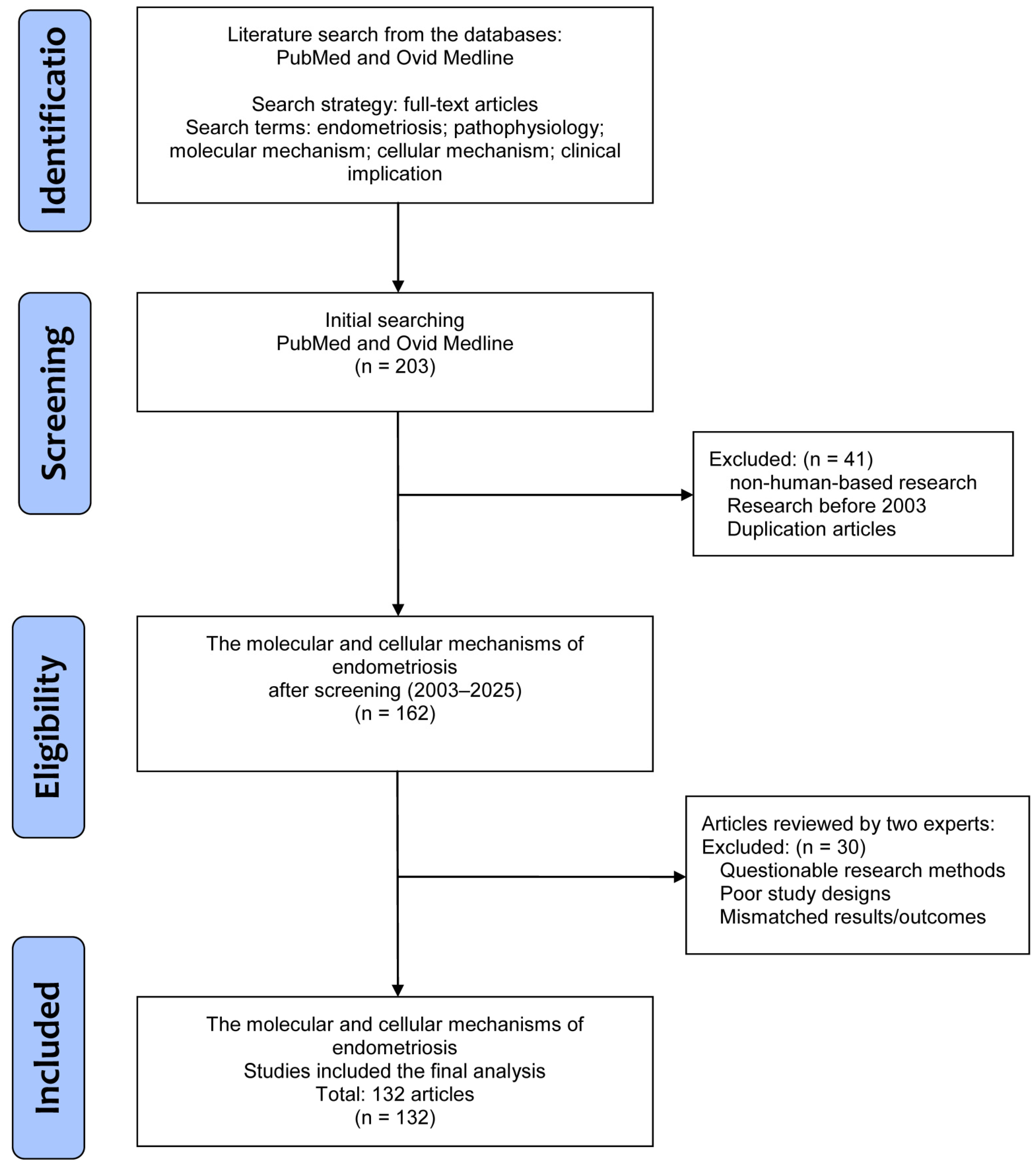
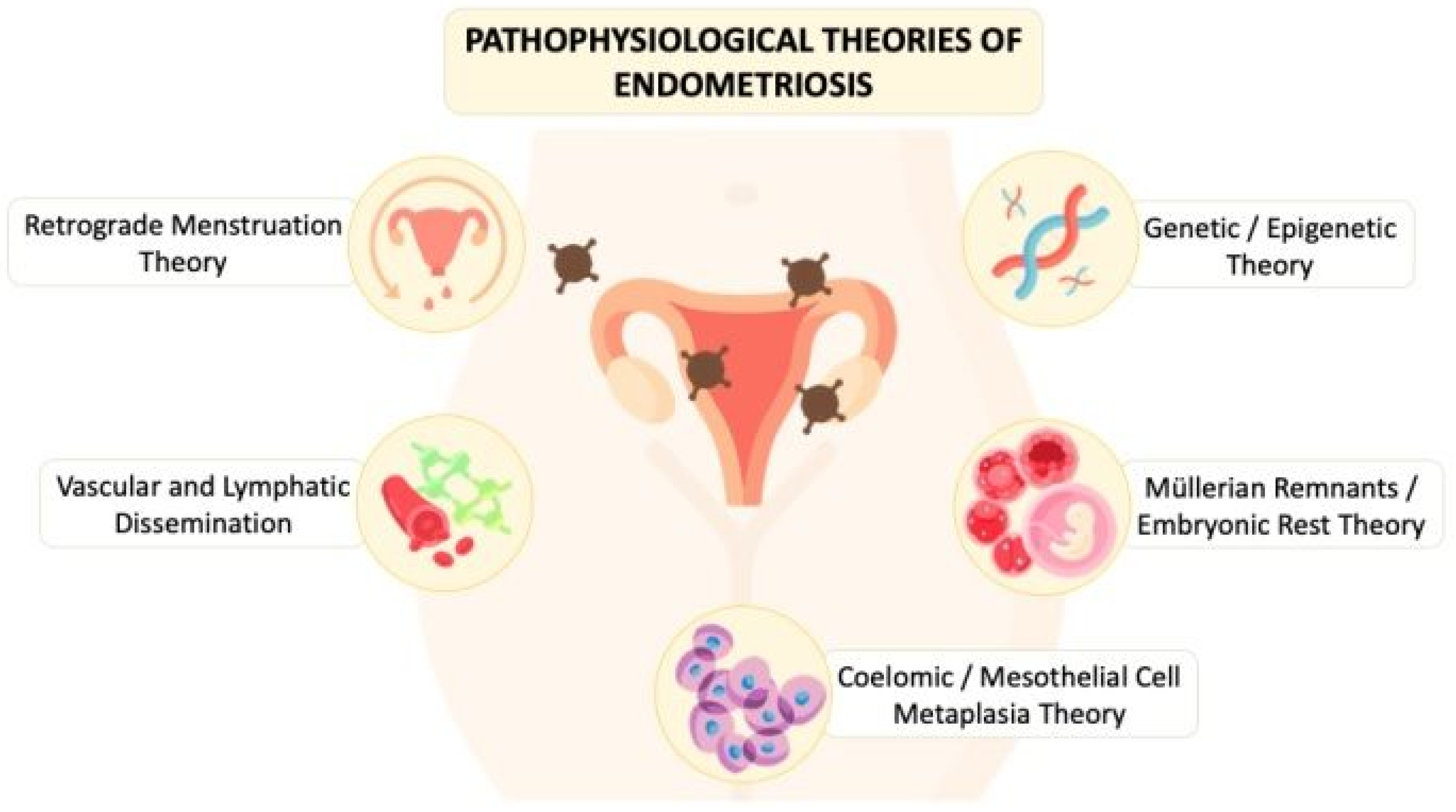
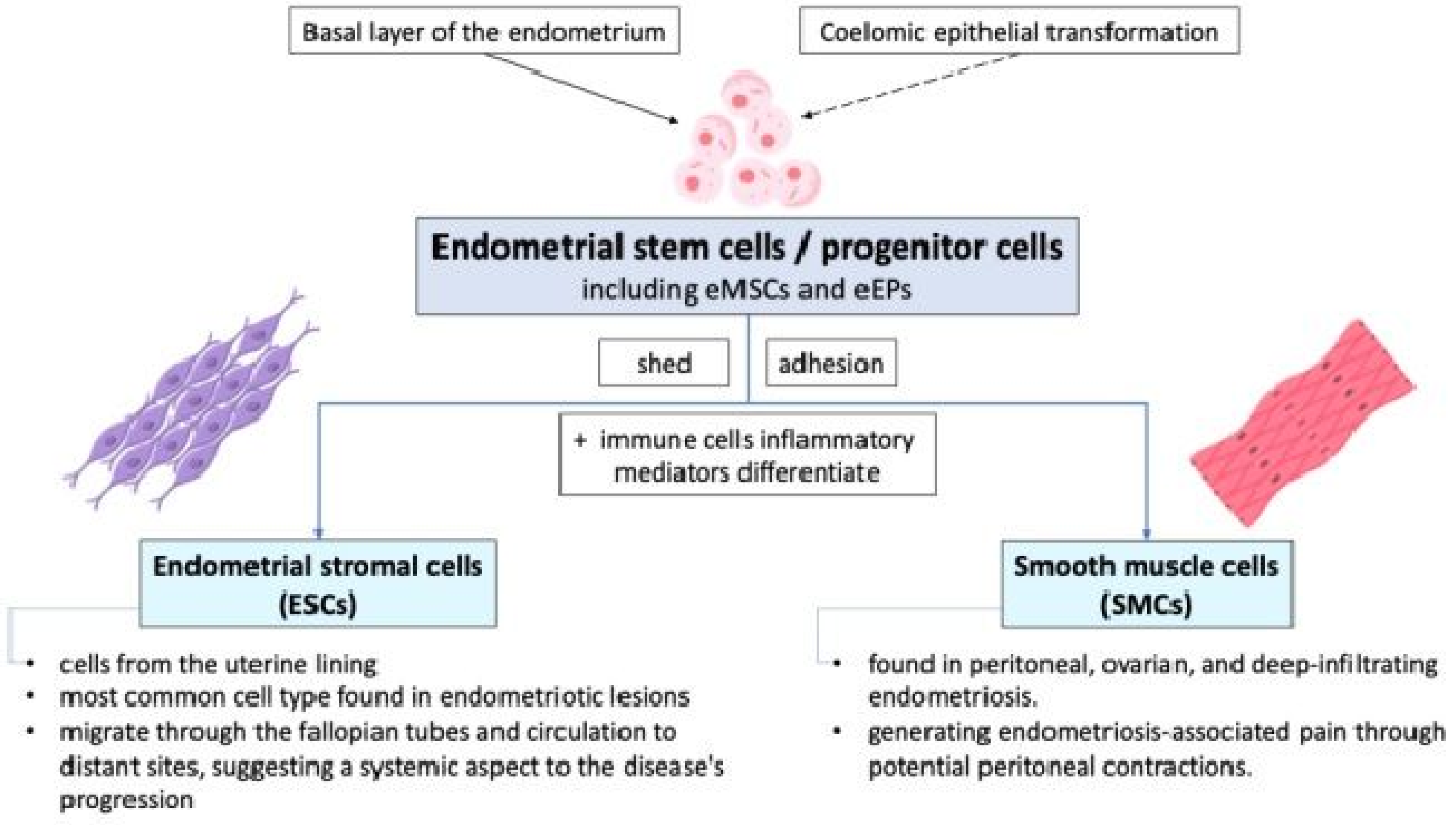
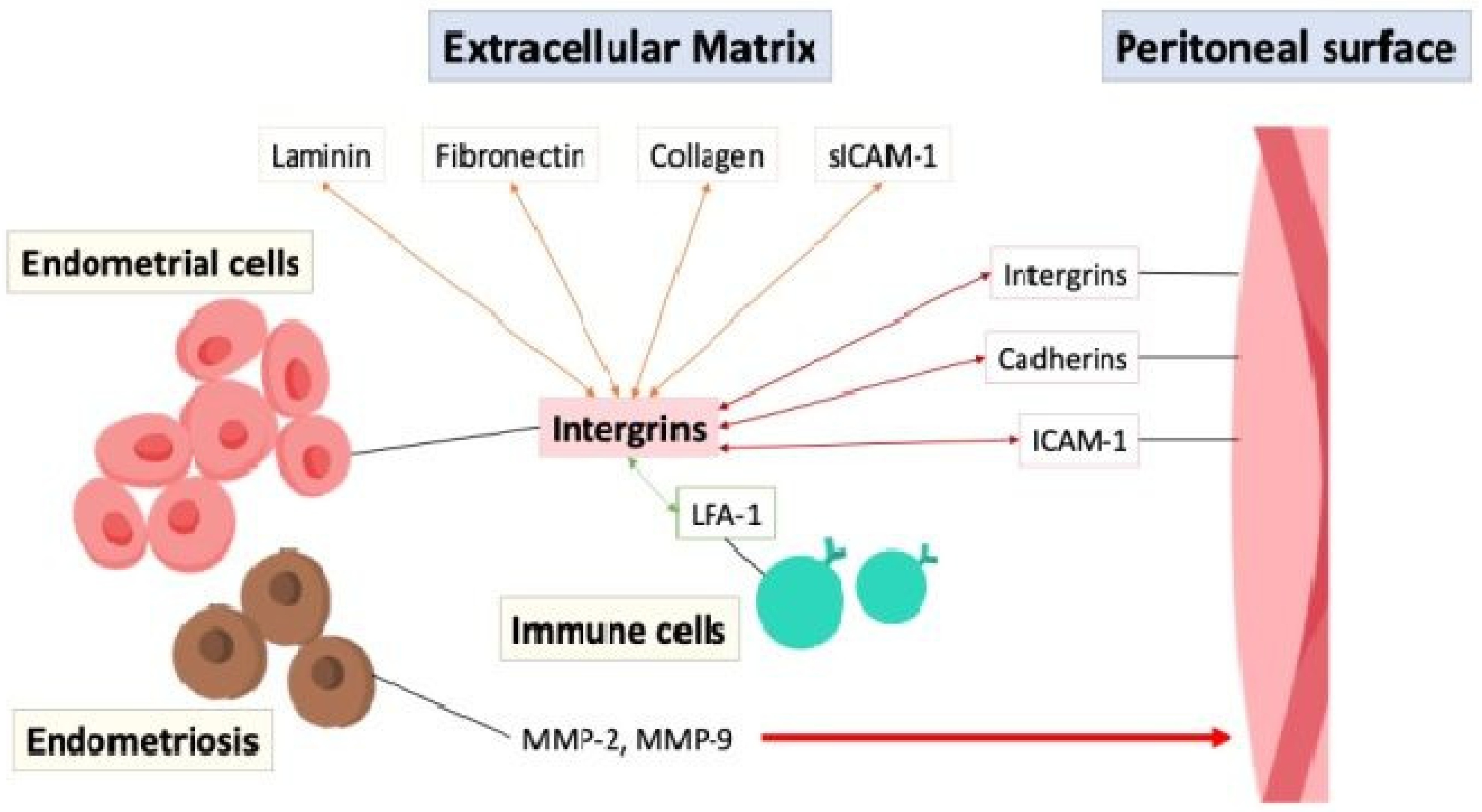
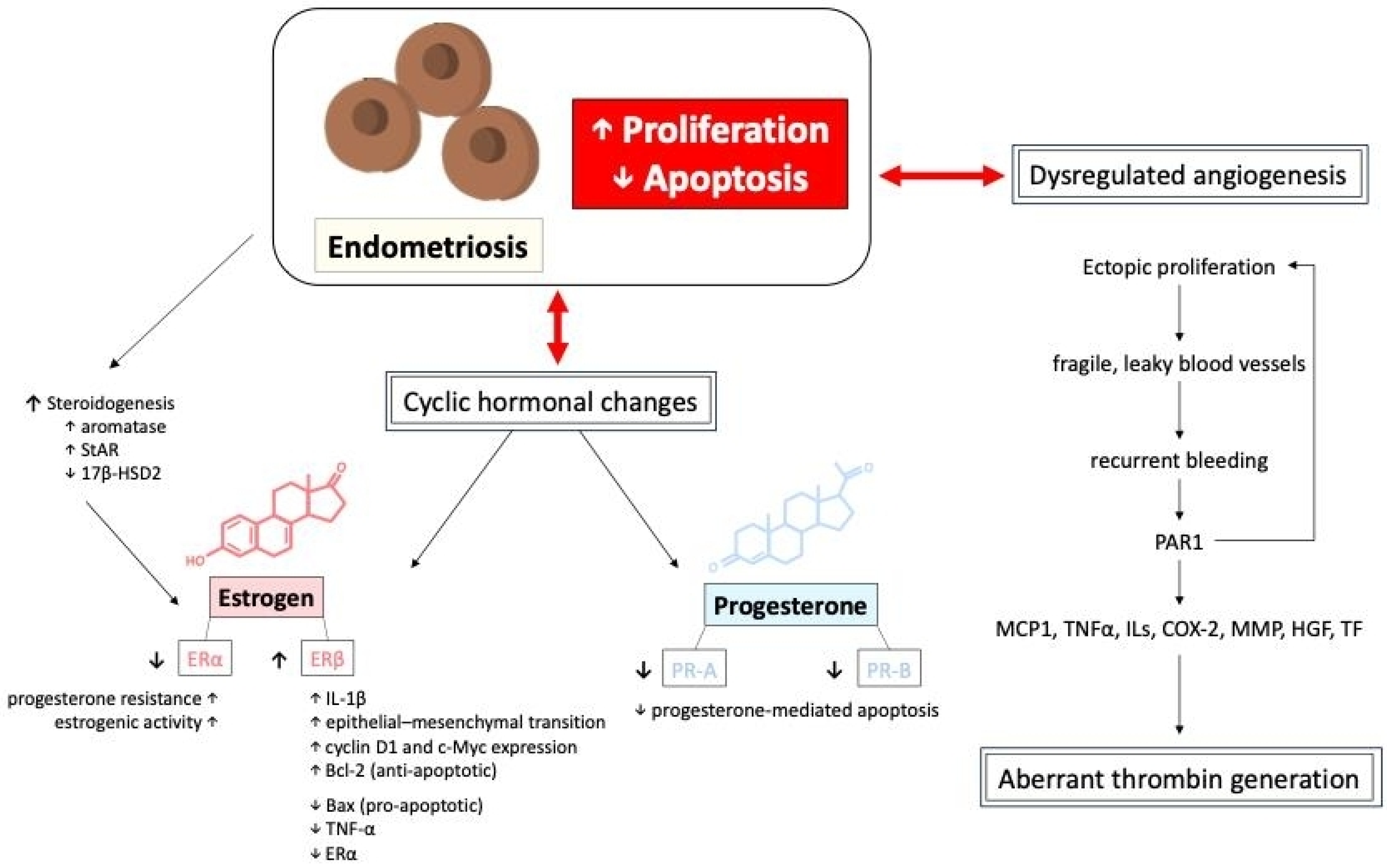
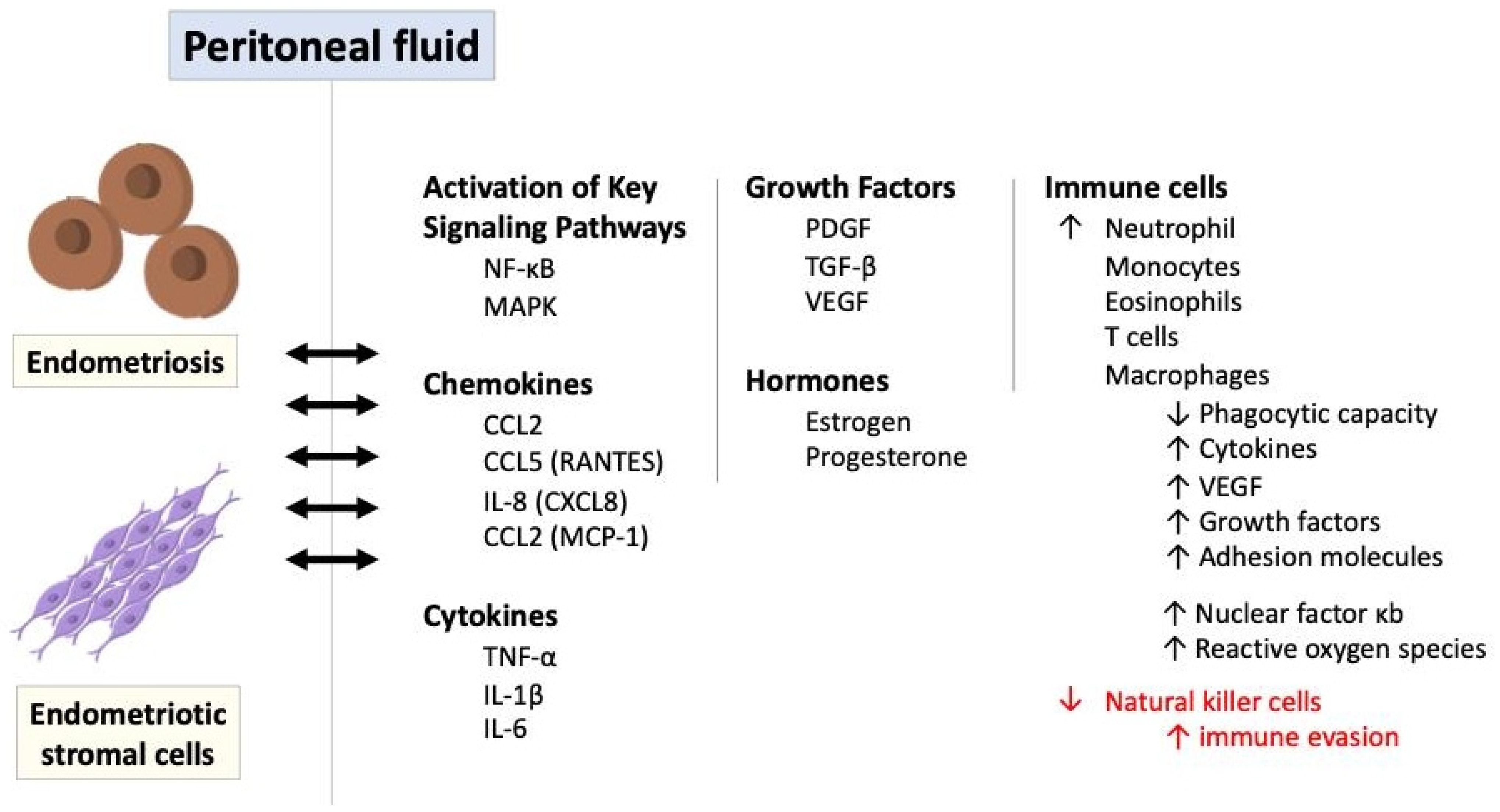
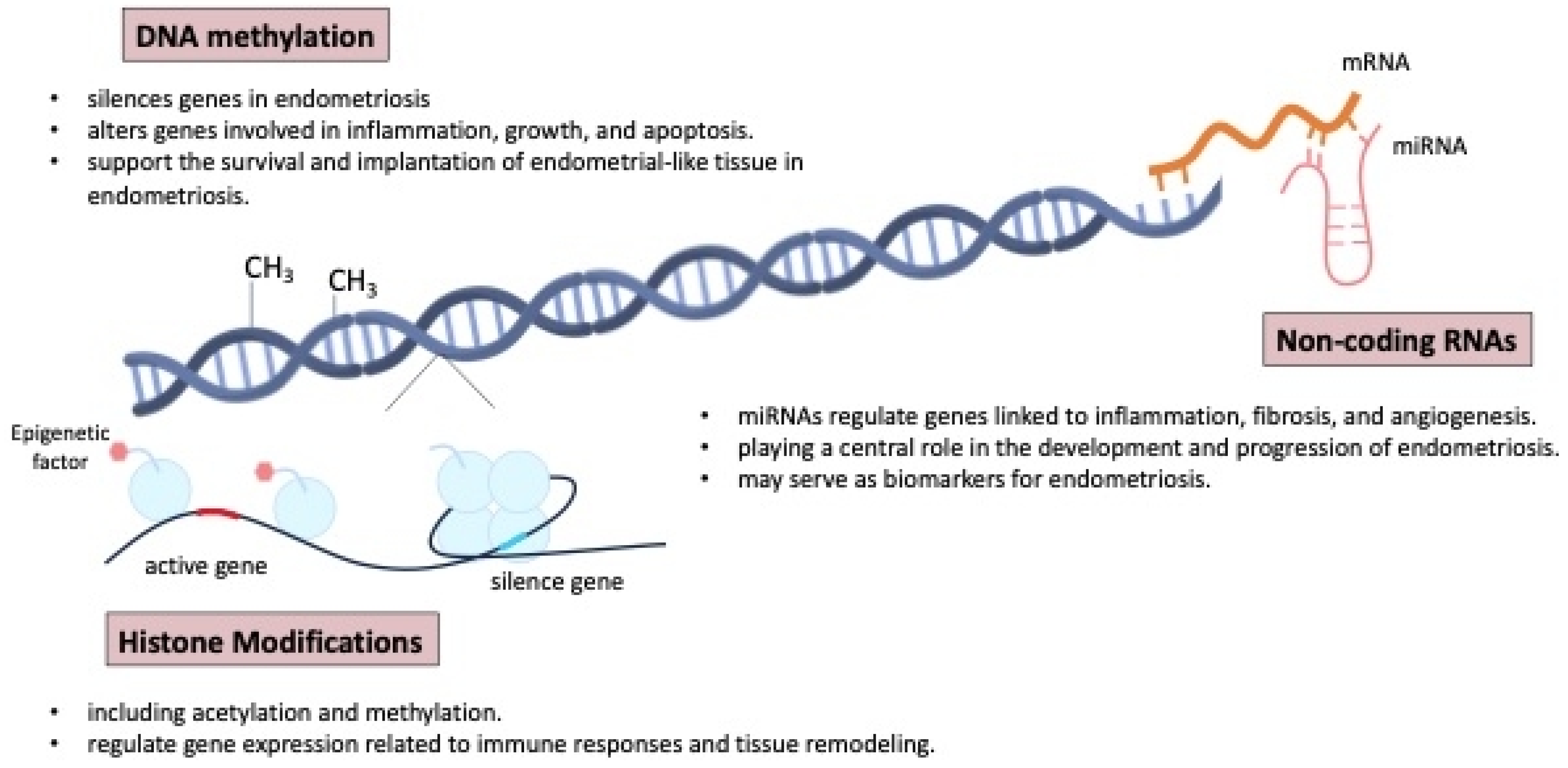
| Organization | Key Diagnostic Points | Differences |
|---|---|---|
| ESHRE | - Emphasizes non-invasive imaging (transvaginal ultrasound, MRI). - Symptoms: chronic pain, infertility. | Recommends reducing reliance on routine laparoscopy for diagnosis. |
| NICE | - Focuses on early symptom recognition (pelvic pain, dysmenorrhea). - Suggests timely specialist referral. | Highlights management pathways alongside diagnostic recommendations. |
| ACOG | - Clinical evaluation as a primary tool. - Laparoscopy as the gold standard for confirmation. | Retains laparoscopy as a key diagnostic method, unlike ESHRE’s reduced emphasis on its routine use. |
| WES | - Promotes unified, evidence-based diagnostic approaches globally. | Collaborates with multiple organizations to create international standards. |
| Medication | Principles of Actions | Possible Side Effects |
|---|---|---|
| Combined Oral Contraceptives (COCs) | Suppress ovulation and induce decidualization and atrophy of endometrial tissue | Elevated risk of gall stone and deep vein thrombosis |
| Progestins | Induce endometrial atrophy and suppress gonadotropin secretion | Irregular uterine bleeding; body weight gain |
| Gonadotropin-Releasing Hormone (GnRH) Agonists and Antagonists | As a modulator of the hypothalamus–pituitary–gonadol axis, GnRH regulates the secretion of gonadotropins (FSH and LH) from the pituitary gland, which in turn control ovarian hormone production and affect the growth of ectopic endometrial tissues | Menopausal syndrome and osteoporosis |
| Aromatase Inhibitors | Inhibit estrogen synthesis within ectopic endometrial tissue and the ovary | Increased risk of osteoporosis and bone fracture; hot flashes; myalgia |
| Nonsteroidal Anti-Inflammatory Drugs (NSAIDs) | Inhibit cyclooxygenase (COX) enzymes and reduce prostaglandin synthesis, alleviating inflammation and nociceptive signaling | Gastrointestinal tract bleeding and ulcer; heartburn |
| Neuromodulators | May be employed as adjunctive therapies to alleviate chronic and neuropathic pain, | Nausea; headache; blurred vision |
| Selective Progesterone Receptor Modulators (SPRMs) | Modulate progesterone activity selectively, reducing lesion growth while preserving endometrial receptivity | Fulminant hepatitis |
| Immunomodulators | Target inflammatory and immune pathways, such as TNF-α inhibitors or interleukin antagonists | Fatigue; diarrhea; nausea |
Disclaimer/Publisher’s Note: The statements, opinions and data contained in all publications are solely those of the individual author(s) and contributor(s) and not of MDPI and/or the editor(s). MDPI and/or the editor(s) disclaim responsibility for any injury to people or property resulting from any ideas, methods, instructions or products referred to in the content. |
© 2025 by the authors. Licensee MDPI, Basel, Switzerland. This article is an open access article distributed under the terms and conditions of the Creative Commons Attribution (CC BY) license (https://creativecommons.org/licenses/by/4.0/).
Share and Cite
Mariadas, H.; Chen, J.-H.; Chen, K.-H. The Molecular and Cellular Mechanisms of Endometriosis: From Basic Pathophysiology to Clinical Implications. Int. J. Mol. Sci. 2025, 26, 2458. https://doi.org/10.3390/ijms26062458
Mariadas H, Chen J-H, Chen K-H. The Molecular and Cellular Mechanisms of Endometriosis: From Basic Pathophysiology to Clinical Implications. International Journal of Molecular Sciences. 2025; 26(6):2458. https://doi.org/10.3390/ijms26062458
Chicago/Turabian StyleMariadas, Heidi, Jie-Hong Chen, and Kuo-Hu Chen. 2025. "The Molecular and Cellular Mechanisms of Endometriosis: From Basic Pathophysiology to Clinical Implications" International Journal of Molecular Sciences 26, no. 6: 2458. https://doi.org/10.3390/ijms26062458
APA StyleMariadas, H., Chen, J.-H., & Chen, K.-H. (2025). The Molecular and Cellular Mechanisms of Endometriosis: From Basic Pathophysiology to Clinical Implications. International Journal of Molecular Sciences, 26(6), 2458. https://doi.org/10.3390/ijms26062458








